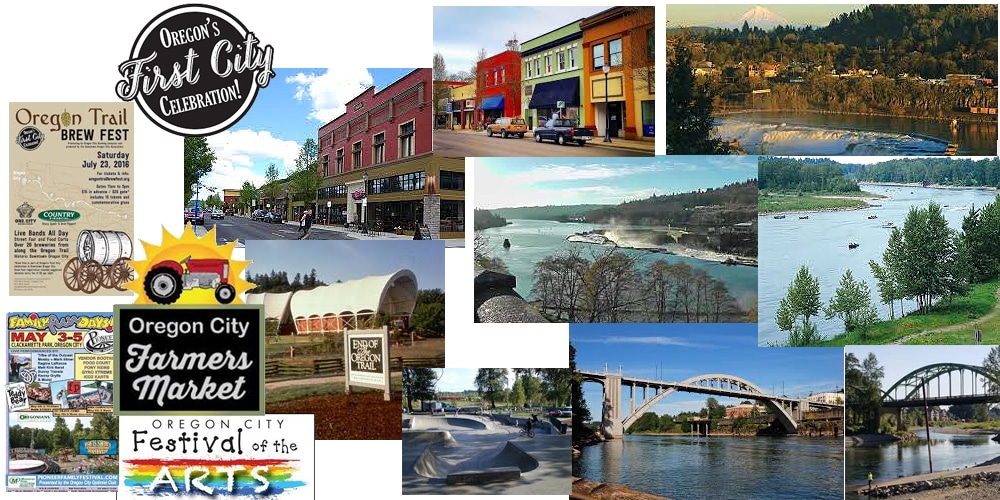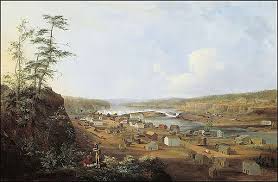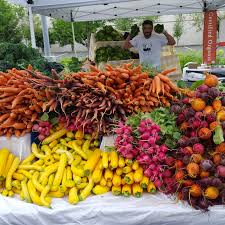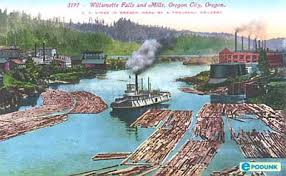
Oregon city photos, Clackamette Park, Willamette Falls,
Oregon City is a great place to live if you are looking for a smaller town feel with great community spirit but still close


enough to Portland to work and play. It was one of the first towns that settled in the Portland area so there are beautiful tree lined streets with homes built around the turn of the century. You see mainly Victorian style but some farmhouse and a few bungalows. That area is very charming! There is the lower part down by the river with great shops and restaurants and then there is the part up the hill that has a couple great shops, cafes, restaurants and a beautiful library. The older homes are up on the hill walking distance to all of this and right near an elevator to the downtown area. The elevator takes you up and down the hill which was built in 1915 and then rebuilt in the late 1955. It is very cool with gorgeous views of the river! People use it all the time! Link

Willamette falls is still huge but has locks for boats to go up and down river

Historic stairs go up from the valley downtown area
Willamette Falls is right downtown and it is breathtaking! It is the 2nd most powerful waterfall in the United States and it is an important part of our cultural history. Learn more about the Willamette Falls Legacy Project that is taking place- a new Riverwalk that connects historic downtown Oregon City to Willamette Falls along the Willamette River. In creating the Riverwalk, the project partners are transforming this abandoned site into a world-class public space, which will begin being built early 2018.
There is a great Farmers Market on Saturdays in the heart of Oregon City. It is a year round market with a showcase showcase for local growers, farmers, ranchers, bakers, artisan food businesses, wineries, distilleries, cideries, breweries, and crafters. The Market also offers hot food and drinks, live music, and kids activities every market day throughout the year. During the summer local chefs demo recipes using seasonal produce, meats and seafood and monthly events entertain the whole family.

Huge farmers market runs most of the year

Clackamas Repertory Theater is a neat program for students to gain professional theatre experience. In 2016, Clackamas Rep spent $62,000 of the annual budget on hiring current and former CCC students. These individuals were hired in all aspects of the theatre as interns, performers, designers, and directors. They strive to provide members of the community with low ticket prices. http://www.clackamasrep.org/about-us/
People are so friendly and you feel like you are part of a warm community where everyone looks out for each other. As you drive out you come to more of a suburbia feel. Lots of newer homes mixed with neighborhoods of homes built from the mid-century on. As you drive even farther out toward the Beaver Creek area, the lots get a lot bigger and you can find 1/2 acre and 1 acre lots mixed with farmland and forest. It is a beautiful area.
Go berry picking at one of the local farms nearby. There are even some wineries in Oregon City.


Wineries and vineyards in Oregon City
If you want to feel like you are in France or Italy, check out these gorgeous grounds at Villa Catalana Cellars. This stunning villa is an architectural gem, built on a hillside next to a large pond.
For a hidden gem, check out Christopher Bridge Winery-
Parks and Trails in Oregon City

Clackamette Park is where the Willamette and Clackamas rivers some together
Clackamette Park is a 2 acre park right on the river where the Clackamas meets the Willamette. It is a very great park great for kayaking, Fishing and boating year round. It is also great for picnics, feeding the ducks, soaking up the sun and some people even swim. There are many festivals that are held in the summer. https://www.orcity.org/parksandrecreation/clackamette-rv-park
Canemah Bluff Natural Area is a great place to take in views of the river. It has trails along the bluff through groves of oak and some madronas. It also connects to the Canemah Neighborhood Children’s Park.
History of Oregon City

I learned about Oregon City back when I was in grade school, in Illinois,

Painting of when the settlers got to end of Oregon Trail
and always wanted to come here! It is the end of the Oregon Trail, the destination of dreams across the desert, where people could own land, and build their futures. It was inhabited by the several Native American tribes, and was the focal point for both fishing salmon and trading. But when the pioneers came, they brought smallpox, cholera and other diseases, which decimated the tribes. There were only 650 Native Americans left in the area by the time the area was settled. They were relocated to Grand Ronde.

The Oregon Trail map

In the 1819s fur traders began coming into the area, and began trapping in the lower Columbia and Willamette rivers, trading their furs to the Hudson Bay company. In 1829, John McLoughlin began laying out a street plan, and started building houses for his workers. The natives burned them down…John built them again. A small fur trading center was opened, and it became the first permanent settlement in the Willamette Valley. And by 1939, there was a small cluster town called Willamette Falls. It slowly grew, had the first Protestant church west of the Rocky Mountains in 1843, was incorporated by 1844, and had a population of 500 by 1846.

The Oregon Territory was officially created in 1848, and Oregon City was the capital. In 1850 the first steamboat on the Willamette was built, agriculture increased, and boats were needed to transport the goods. Because the falls initially required the movement of freight from one ship to another, shipbuilding enterprises developed at both Canemah (above the falls) and Oregon City (below the falls). Shipbuilding was more prolific at Canemah, but at least eight steamboats were built in Oregon City in the 1850s and 1860s.

The first paper mill came into Oregon City in 1866, and the RR arrived in 1869. Willamette Locks were built in 1873 so that ships could get all the way up the river, and Oregon City continued to grow! In 1889 electric power came to the Portland area, and the

electric RR opened between Portland and Oregon City in 1893. The first car arrived in 1903, and it has been growing and changing ever since.
Oregon City had several floods, the last one being 1996, when the downtown area was badly flooded. But most of the houses were built up the hill, which goes steeply up to a plateau above the Willamette River. This area still has blocks and neighborhoods of cool old historic homes. I have always loved showing those houses to people. Each one is unique and it is fascinating to think what life must have been like for the people who built them!


Oregon City had several floods, the last one being 1996, when the downtown area was badly flooded. But most of the houses were built up the hill, which goes steeply up to a plateau above the Willamette River. This area still has blocks and neighborhoods of cool old historic homes. I have always loved showing those houses to people. Each one is unique and it is fascinating to think what life must have been like for the people who built them.
Special Interest
Museum of the Oregon Territory overlooks Willamette Falls, and has history all the way from the early Indian times, through the fur traders, the pioneers and the early merchants.

The outside of museum
End of the Oregon Trail museum is amazing. It is a living, hands on museum where kids can see, touch and feel what it was like to be an early pioneer. My grandchildren like it, they made their own candles, loaded a covered wagon, and played in an old town setting. The museum is at the end of the Barlow Trail, which was the gateway into the Willamette Valley.

End of Oregon Trail setting showing life along the trail

The end of the Oregon Trail has amazing displays, hands on crafts and activities and is a living museum


